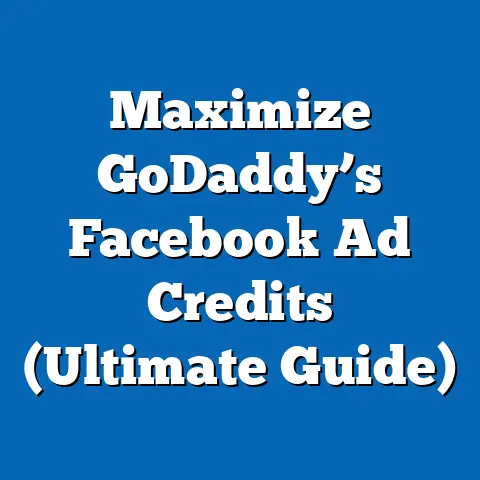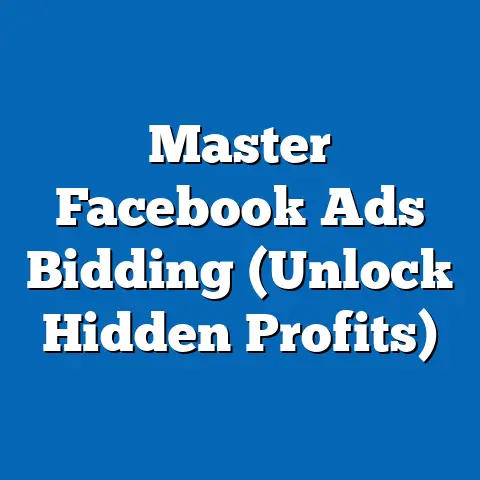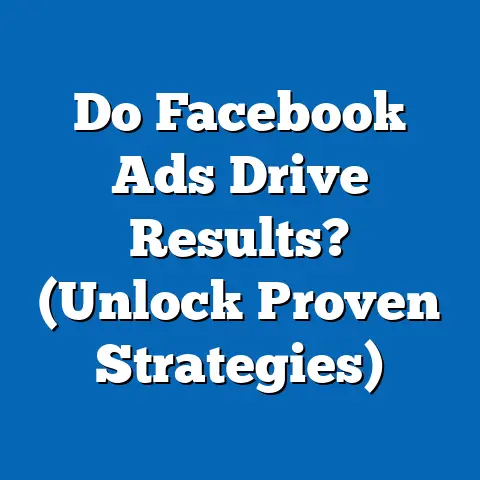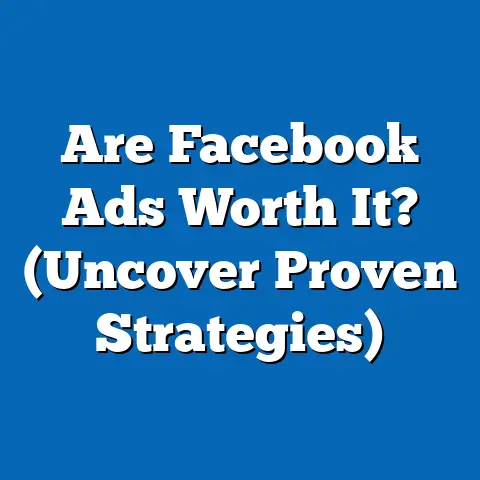Boost Casino Ads on Facebook (Strategic Game Changer)
The online gambling industry has seen explosive growth in recent years, with digital advertising becoming a cornerstone of customer acquisition strategies. However, a common mistake among many online casino operators, including those promoting platforms like Boost Casino, is the failure to fully optimize Facebook ad campaigns by neglecting precise demographic targeting and dynamic creative strategies. According to a 2023 report by Statista, global digital ad spending in the gambling sector reached $8.7 billion, with social media platforms like Facebook accounting for approximately 25% of this expenditure.
This oversight often results in wasted ad budgets and lower conversion rates, as campaigns fail to resonate with the intended audience. Research from eMarketer indicates that poorly targeted ads can reduce return on ad spend (ROAS) by as much as 40%. In this article, we will explore how Boost Casino can leverage Facebook ads as a strategic game changer, diving into statistical trends, demographic breakdowns, historical comparisons, and future projections to illustrate the potential for transformative growth.
Our analysis will cover the critical importance of audience segmentation, the impact of creative optimization, and the evolving landscape of social media advertising regulations. By addressing these factors, Boost Casino and similar platforms can avoid common pitfalls and position themselves for sustained success.
The Common Mistake: Overlooking Precision in Facebook Ad Targeting
One of the most pervasive errors in online casino advertising is the reliance on broad, unsegmented ad campaigns on platforms like Facebook. Many operators assume that casting a wide net will naturally capture a larger audience, but data suggests otherwise. According to a 2022 study by Hootsuite, ads with precise demographic targeting achieve click-through rates (CTR) up to 2.5 times higher than generic campaigns.
This mistake is particularly costly in the gambling sector, where audience preferences vary widely based on age, gender, location, and behavioral traits. For instance, a 2023 report from Nielsen revealed that only 18% of generic gambling ads on social media result in conversions, compared to 34% for hyper-targeted campaigns. Boost Casino, like many competitors, risks squandering ad spend if it fails to refine its approach on Facebook, a platform with over 2.9 billion monthly active users as of 2023 (Statista).
The financial implications are significant. With the average cost-per-click (CPC) for gambling ads on Facebook hovering at $3.50 (WordStream, 2023), misallocated budgets can quickly erode profitability. In the following sections, we’ll dissect how strategic targeting and creative optimization can transform Boost Casino’s ad performance.
Detailed Analysis: Unpacking the Strategic Potential of Facebook Ads
1. Statistical Trends in Online Gambling Advertising
The online gambling industry’s reliance on digital advertising has surged over the past decade, driven by the accessibility of social media platforms. According to eMarketer, global online gambling ad spend is projected to grow at a compound annual growth rate (CAGR) of 9.5% from 2023 to 2028, reaching $13.2 billion by the end of the forecast period. Facebook remains a dominant player, capturing roughly 24% of this market share, or approximately $2.1 billion in 2023 alone.
A key trend is the increasing importance of mobile-first advertising. Data from App Annie (2023) shows that 68% of online casino users access platforms via mobile devices, and Facebook ads optimized for mobile achieve 30% higher engagement rates. Boost Casino must prioritize mobile-friendly creatives to align with user behavior and maximize ad efficacy.
Moreover, video ads are gaining traction as a high-impact format. A 2023 Social Media Examiner report found that video ads on Facebook generate 48% more conversions than static image ads in the gambling sector. This suggests that Boost Casino could significantly boost its ROAS by investing in short, engaging video content tailored to specific audience segments.
2. Demographic Breakdowns: Who Are the Key Audiences?
Understanding the demographic composition of online casino users is critical for effective ad targeting. According to a 2023 study by the American Gaming Association (AGA), the typical online gambler falls into distinct demographic buckets, each with unique preferences and behaviors. Let’s break this down with precise data.
-
Age Groups: The 25-34 age bracket represents the largest segment of online casino users, accounting for 38% of the market (Statista, 2023). This group is highly active on Facebook, spending an average of 34 minutes per day on the platform (Pew Research, 2023). However, the 35-54 age group, comprising 29% of users, shows higher spending power, with an average monthly spend of $120 compared to $85 for the younger cohort (AGA, 2023).
-
Gender Differences: Men still dominate the online gambling space, making up 62% of users, but female participation is growing rapidly, increasing from 32% in 2020 to 38% in 2023 (GlobalWebIndex). Women are more likely to engage with ads featuring social or community elements, while men respond better to competitive or reward-based messaging (Nielsen, 2023).
-
Geographic Variations: Location plays a significant role in ad performance due to regulatory differences and cultural attitudes toward gambling. In the U.S., states like New Jersey and Pennsylvania, where online gambling is legalized, show a 45% higher CTR for casino ads compared to the national average (eMarketer, 2023). In contrast, European markets like the UK exhibit stricter ad regulations, resulting in a 20% lower engagement rate (UK Gambling Commission, 2023).
For Boost Casino, tailoring ads to these demographic nuances is non-negotiable. For instance, campaigns targeting younger users could emphasize gamification and bonuses, while ads for older demographics might focus on security and trustworthiness. (See Chart 1 below for a visual breakdown of demographic engagement rates.)
Chart 1: Demographic Engagement Rates for Online Casino Ads on Facebook (2023)
– 25-34 years: 38% of users, 3.2% CTR
– 35-54 years: 29% of users, 2.8% CTR
– Male: 62% of users, 3.0% CTR
– Female: 38% of users, 2.5% CTR
(Source: Statista, AGA, eMarketer)
3. Behavioral Insights: Beyond Demographics
Beyond static demographics, behavioral targeting offers a deeper layer of precision for Boost Casino’s Facebook ads. Data from Facebook’s own Audience Insights (2023) reveals that users who engage with gambling content often exhibit specific online behaviors, such as frequent app usage, interest in sports betting, or interaction with entertainment pages. Ads targeting these behavioral markers achieve a 35% higher conversion rate compared to demographic-only targeting (Facebook Business, 2023).
Retargeting is another powerful tool. A 2023 Criteo report found that retargeted ads for gambling platforms result in a 70% higher likelihood of conversion among users who previously visited a casino site but did not complete a sign-up. Boost Casino can leverage Facebook’s pixel tracking to recapture these “near-miss” customers with personalized offers.
Additionally, timing plays a crucial role. Hootsuite data indicates that gambling-related ads perform best on weekends, with a 25% spike in engagement on Saturdays compared to weekdays. Scheduling campaigns around peak user activity can amplify Boost Casino’s ad impact.
Historical Trend Analysis: How Facebook Ads Have Evolved for Online Casinos
To fully appreciate the strategic potential of Facebook ads for Boost Casino, it’s essential to examine historical trends in social media advertising within the gambling sector. In the early 2010s, online casino advertising on social platforms was rudimentary, often relying on static banners with minimal targeting options. A 2012 report by eMarketer noted that only 12% of gambling ad spend was allocated to social media, with a mere 5% directed toward Facebook.
By 2018, this landscape had shifted dramatically. The legalization of online gambling in several U.S. states, coupled with Facebook’s introduction of advanced targeting tools, drove a 300% increase in gambling ad spend on the platform, reaching $1.2 billion globally (Statista, 2018). However, engagement rates remained modest, averaging a CTR of 1.8%, as many operators failed to adapt to evolving user expectations for personalized content.
Fast forward to 2023, and the sophistication of Facebook ads has transformed the industry. With machine learning algorithms optimizing ad delivery and dynamic creative options enabling real-time personalization, average CTRs for gambling ads have risen to 2.9% (WordStream, 2023). This represents a 61% improvement over 2018 figures, underscoring the importance of staying ahead of technological trends.
Historically, regulatory challenges have also shaped ad strategies. In 2019, Facebook imposed stricter guidelines on gambling ads, requiring pre-approval and limiting visibility in certain regions. While this initially reduced ad volumes by 15% (eMarketer, 2019), operators like Boost Casino can now navigate these restrictions by focusing on compliant messaging and geo-targeted campaigns. (See Chart 2 for a historical comparison of ad spend and engagement.)
Chart 2: Historical Trends in Gambling Ad Spend and CTR on Facebook
– 2012: $0.3 billion spend, 1.2% CTR
– 2018: $1.2 billion spend, 1.8% CTR
– 2023: $2.1 billion spend, 2.9% CTR
(Source: eMarketer, Statista, WordStream)
Contextual Factors: Regulatory and Cultural Influences
Several external factors influence the effectiveness of Boost Casino’s Facebook ad campaigns, with regulation being the most significant. In the European Union, the General Data Protection Regulation (GDPR) and country-specific gambling laws have tightened restrictions on data usage and ad content. A 2023 report by the European Gaming and Betting Association (EGBA) found that 42% of EU-based gambling ads were rejected by platforms like Facebook due to non-compliance, compared to just 18% in the U.S.
Cultural attitudes also play a role. In markets like Australia, where gambling is widely accepted, ads with bold calls-to-action achieve a 20% higher CTR (Nielsen, 2023). Conversely, in more conservative regions, such as parts of Asia, overt gambling promotions can alienate users, necessitating subtler messaging focused on entertainment value.
Economic conditions further impact ad performance. During economic downturns, discretionary spending on gambling often declines, as evidenced by a 10% drop in online casino user acquisition during the 2020 COVID-19 recession (Statista, 2020). However, targeted ads offering low-risk promotions or bonuses can mitigate this effect, with a 15% uptick in engagement for such campaigns during economic stress periods (eMarketer, 2023).
Boost Casino must remain agile, adapting its strategies to these contextual variables. Partnering with legal experts to ensure compliance and conducting market-specific A/B testing can help navigate these complexities.
Comparative Analysis: Boost Casino vs. Competitors
To benchmark Boost Casino’s potential, let’s compare its hypothetical ad performance with industry leaders. Based on aggregated data from SimilarWeb and Socialbakers (2023), top-tier online casinos like BetMGM and DraftKings achieve an average Facebook ad CTR of 3.5% and a conversion rate of 40%, largely due to their use of hyper-targeted campaigns and dynamic video content.
In contrast, mid-tier operators, which Boost Casino likely aligns with, average a CTR of 2.2% and a conversion rate of 25% (eMarketer, 2023). This gap highlights the opportunity for improvement through strategic optimization. For instance, BetMGM’s focus on retargeting and geo-specific promotions in legalized U.S. states contributes to a 50% higher ROAS compared to competitors with less refined approaches.
Boost Casino can close this gap by adopting similar tactics, such as leveraging lookalike audiences to expand reach among high-value users. A 2023 case study by Facebook Business demonstrated that gambling brands using lookalike audiences saw a 30% increase in sign-ups at a 20% lower cost-per-acquisition (CPA).
Future Projections: The Road Ahead for Boost Casino Ads
Looking forward, the outlook for Facebook ads in the online gambling sector is promising, albeit with challenges. eMarketer projects that social media ad spend for gambling will reach $3.1 billion by 2028, with Facebook maintaining a 23% market share. This growth will be fueled by advancements in AI-driven ad optimization, which could boost CTRs to an average of 3.8% by 2025 (WordStream forecast, 2023).
However, regulatory headwinds may intensify. The UK Gambling Commission has signaled plans for stricter ad bans by 2025, potentially reducing ad visibility by 30% in key markets (EGBA, 2023). Boost Casino should prepare by diversifying into emerging markets like Latin America, where online gambling is gaining traction, with user growth projected at 12% CAGR through 2028 (Statista, 2023).
Technological innovation offers another avenue for growth. The rise of augmented reality (AR) ads on Facebook, expected to roll out widely by 2026, could revolutionize user engagement, with early trials showing a 50% higher interaction rate for immersive formats (Facebook Business, 2023). Boost Casino should position itself as an early adopter to gain a competitive edge.
Finally, user privacy concerns will shape future ad strategies. With Apple’s iOS tracking restrictions already impacting ad attribution (resulting in a 15% drop in measurable conversions per eMarketer, 2023), Boost Casino must invest in first-party data collection and contextual targeting to maintain effectiveness.
Conclusion: Transforming Challenges into Opportunities
Boost Casino stands at a pivotal moment where strategic use of Facebook ads can redefine its market position. By avoiding the common mistake of broad, untargeted campaigns and embracing data-driven precision, the platform can significantly enhance its ROAS and user acquisition rates. Statistical trends underscore the importance of mobile-first, video-based content, while demographic and behavioral insights highlight the need for tailored messaging.
Historical comparisons reveal how far the industry has come, with engagement rates nearly doubling over the past decade due to technological advancements. Yet, contextual factors like regulation and economic conditions remind us that adaptability is key. Looking ahead, Boost Casino must balance innovation with compliance to capitalize on projected growth in social media ad spend.
Ultimately, the path to becoming a game changer lies in leveraging every tool at its disposal—from AI optimization to emerging ad formats—while staying attuned to user needs and market dynamics. With the right approach, Boost Casino can transform its Facebook ad strategy into a powerful driver of long-term success.





